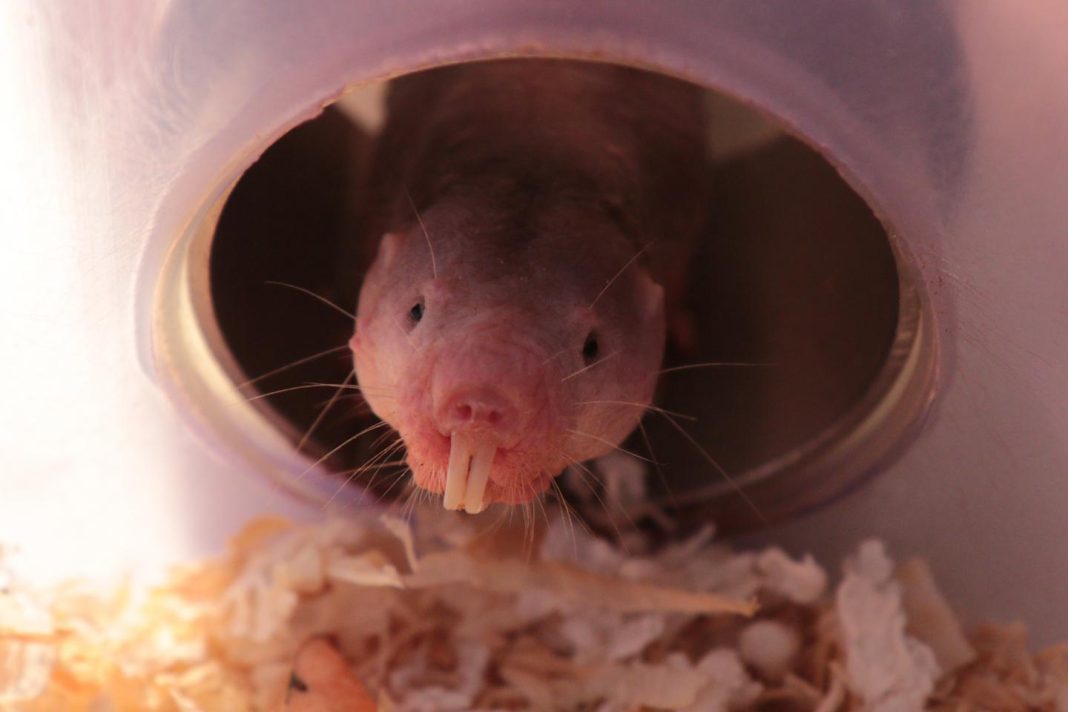![A naked mole-rat peeks out of the tube of an artificial burrow. For this burrow-dwelling animal, and all of his wrinkly kin, the metabolic rewiring of glycolysis can circumvent the normally lethal effects of oxygen deprivation, a mechanism that could be harnessed to minimize hypoxic damage in human disease. [Roland Gockel/MDC]](https://genengnews.com/wp-content/uploads/2018/08/Apr21_2017_MDC_NakedMoleRat2201391782-1.jpg)
A naked mole-rat peeks out of the tube of an artificial burrow. For this burrow-dwelling animal, and all of his wrinkly kin, the metabolic rewiring of glycolysis can circumvent the normally lethal effects of oxygen deprivation, a mechanism that could be harnessed to minimize hypoxic damage in human disease. [Roland Gockel/MDC]
The naked mole-rat is even more remarkable than we knew. Renowned for its longevity, resistance to cancer, and ability to adopt the ambient temperature as its own body temperature, this unprepossessing rodent, this cold-blooded mammal, also has a previously unknown metabolic trick up its sleeve—or tucked into its wrinkled skin.
The naked mole-rat, or sand puppy, can generate energy from fructose, bypassing the usual glucose pathway, which requires oxygen. This metabolic quirk explains how the naked mole-rat can survive—even thrive—in crowded burrows and stuffy underground passages, confines where oxygen is frequently scarce.
Naked mole-rats revealed how they endure low-oxygen conditions in a study led by scientists at the University of Illinois in Chicago. These scientists observed that naked mole-rats can not only tolerate hours of extreme hypoxia, they can even survive 18 minutes of total oxygen deprivation (anoxia) without apparent injury.
To understand how the naked mole-rat is capable of such feats, the scientists dug deep into the rodent’s metabolism. They found that during anoxia, the naked mole-rat switches to anaerobic metabolism fueled by fructose, which is actively accumulated and metabolized to lactate in the brain.
Details of this work appeared April 21 in the journal Science, in an article entitled, “Fructose-Driven Glycolysis Supports Anoxia Resistance in the Naked Mole-Rat.” Essentially, the article explains how the metabolic switch from glucose to fructose maintains the animal’s energy supply and prevents tissue damage when oxygen goes missing.
“Global expression of the GLUT5 fructose transporter and high levels of ketohexokinase were identified as molecular signatures of fructose metabolism,” wrote the authors of the Science paper. “Fructose-driven glycolytic respiration in naked mole-rat tissues avoids feedback inhibition of glycolysis via phosphofructokinase, supporting viability.”
Many mammals can draw on fructose as an energy source, but only in very specific tissues. It can only be used if two components are present. The first is GLUT5, a transporter molecule that draws fructose from the blood into cells. In most mammals, GLUT5 is present only in the liver and kidney. But Jane Reznick, a co-author of the Science paper and a researcher at the Max Delbrück Center for Molecular Medicine, found it throughout the mole-rat's body.
The second component is an enzyme called KHK, or ketohexokinase, which alters fructose so that it can be fed into an energy-providing pathway called glycolysis while at the same time dodging a highly regulated step of glycolysis that is blocked when oxygen levels are low. The mole-rats also had plenty of KHK throughout their bodies. The lack of these two components in the brain and heart of humans and other mammals jams up glycolysis when they are deprived of oxygen. No energy can therefore be provided to power these tissues and the organs quickly fail.
Oddly enough, when naked mole-rats are deprived of oxygen, they can survive by metabolizing fructose just as plants do. Moreover, naked mole-rats are protected from another deadly aspect of low oxygen—a buildup of fluid in the lungs called pulmonary edema that afflicts mountain climbers at high altitude.
The authors of the Science paper speculate that understanding how the animals metabolize fructose could lead to treatments for patients suffering crises of oxygen deprivation, as in heart attacks and strokes.



